RQA Indicator Spotlight: Manufacturing & Services ism
In this month’s economic data spotlight, we take a look at the Institute for Supply Management (the “ISM”; also referenced as “PMI” data) for both manufacturing and services, and in particular, recent changes in trends and how dispersions within the data can help provide insight into overall economic activity.
Manufacturing ISM data is a key economic indicator that provides insights into the health and performance of the manufacturing sector in the United States. It is based on a monthly survey conducted by the Institute for Supply Management involving a panel of purchasing managers and supply chain professionals from various industries. This survey collects information on factors such as new orders, production levels, employment, supplier deliveries, and inventory levels within the manufacturing sector. The data is presented in the form of an index, where a reading above 50 typically indicates expansion in the sector, while a reading below 50 suggests contraction.
Manufacturing ISM data is closely monitored by economists, investors, and policymakers, as it offers valuable information about the direction of manufacturing activity, which can have significant implications for the broader economy, including employment trends and inflation.
Services ISM data, also provided by the Institute for Supply Management, is analogous to manufacturing ISM data but focuses on the services sector. The services sector encompasses a wide range of industries, such as healthcare, finance, retail, and hospitality, which provide intangible services rather than tangible goods. The Services ISM survey collects information on various aspects of the services sector, including business activity, new orders, employment, supplier deliveries, and inventories. Similar to manufacturing ISM, the data is presented as an index, with readings above 50 indicating expansion and readings below 50 indicating contraction in the services sector. Services ISM data is vital for assessing the overall health of the services-based economy, which often represents a substantial portion of a country's GDP and employment. Similar to Manufacturing ISM, policymakers and analysts rely on this data to gauge trends in consumer and business spending, as well as the resilience of the services sector during economic fluctuations.
Source: Data from FRED.
Manufacturing ISM and Services ISM data often move in tandem but can provide distinct insights into different aspects of the U.S. economy. When both data sets are simultaneously above 50, it generally signifies a broad-based economic expansion - with manufacturing data indicating increased demand for goods, while services data demonstrates a robust consumer and business spending environment. Conversely, if both readings fall below 50, it can signal a comprehensive economic contraction, with manufacturing reflecting reduced production and services pointing to weakened consumer confidence and spending.
Source: Analysis by RQA. Data from FRED.
Discrepancies between the two data sets, however, can offer nuanced insights. For instance, when Manufacturing ISM is strong (above 50) while Services ISM lags (below 50), it may suggest that the manufacturing sector is thriving due to international demand or capital investment, but the broader economy could be facing challenges, potentially driven by reduced consumer spending. Conversely, robust Services ISM coupled with a weak Manufacturing ISM might indicate that the services sector is supporting economic growth through consumer-driven spending, while manufacturing faces headwinds like trade tensions or supply chain disruptions. In summary, analyzing the relationship between these two data sets helps provide a more comprehensive understanding of the U.S. economy, its drivers, and potential areas of concern during periods of growth or contraction.
Recently, the ISM data has revealed a divergence in the well-being of the manufacturing and services economies. This divergence suggests that the overall state of the economy lacks clarity until these two data series align. As we move forward, it's key to monitor how this divergence evolves. Doing so will provide deeper insights into the overall economic strength or its absence.
Economic Forecast Model
Stepping back to look across multiple economic leading indicators and predictor variables, the RQA Economic Forecast Model has recorded its second month in positive territory – ending July at a reading of 0.14 (up from 0.02 last month). Continued robustness within the Labor Composite and positive shifts within the Financial and Sentiment data provided support for the positive forecast.
While this recent upward trajectory bodes well for continued optimism, the current readings remain modest and near the zero-line, meaning many fundamental leading indicators tracked by the model are giving mixed signals.
Source: Analysis by RQA. Data from U.S. Federal Reserve; Bureau of Labor Statistics; Norgate Premium Data; Institute for Supply Management
The RQA Economic Forecast Model represents a consolidated composite of key economic leading indicators and market-based explanatory variables. The goal of this composite model is to present a holistic measure of primary U.S. economic growth drivers and their trends over time. (Additional detail on the model’s construction is provided here.)
Values above the zero-line are indicative of positive U.S. economic growth expectations in the near-term, and therefore, indicate economic strength and lesser chance of recessionary pressure. On the other hand, values below the zero-line represent the opposite - a more negative outlook and more elevated probabilities of the U.S. experiencing an economic contraction.
TAKING A CLOSER LOOK AT THE ECONOMIC DRIVERS
In the economic heatmap below, we are able to peak under the hood at a wide mix of underlying growth drivers in the U.S. economy. By reviewing this underlying data in more detail, we are better able to see how the underlying components of the U.S. economic growth picture are behaving through time. The indicators presented below have each proven to have predictive qualities in estimating the future direction of U.S. economic growth.
Source: Analysis by RQA. Data from U.S. Federal Reserve; Bureau of Labor Statistics; Norgate Premium Data; Institute for Supply Management
In reviewing the data reported through July, the key indicators driving this continued shift into positive territory are:
Momentum in consumer sentiment, consumer spending, real personal incomes, and services sector PMI data;
U.S. large cap stocks as tracked by the S&P 500 index continue to register year over year strength, indicating improved investor sentiment and market expectations for future growth;
Labor market data, particularly unemployment claims, continues to show resiliency in the face of rising rates;
Financial market indicators, excluding the aforementioned S&P 500, remain fairly pessimistic, as yield curves remain inverted and corporate bond spreads remain elevated; and
As for the contrary signals, manufacturing PMI, industrial production, and new residential building permits continue to signal weakness in the economy – along with elevated corporate bond spreads and the continued inversion of the treasury yield curve.
MARKET REGIME DISCUSSION
The recent shifts in the RQA economic model, moving into positive territory, indicate a potential for near-term economic growth. This shift aligns with the broader economic indicators discussed earlier, such as improvements in the labor market and consumer spending. However, one key factor casting a shadow over this positive outlook is elevated inflation. While recent trends show some stabilization, inflation remains above the Federal Reserve's target mandate. This inflationary pressure poses a challenge to the economic landscape.
Given the interplay between economic growth and inflation, two possible scenarios emerge. If economic growth firms up and stabilizes, there's a likelihood of transitioning into the quadrant of inflationary boom. This scenario implies that growth could be strong enough to support increased consumer demand, potentially pushing prices higher. On the other hand, if growth fails to materialize while inflation remains steady, a stagflation-oriented environment becomes more likely. Stagflation, characterized by stagnant growth combined with high inflation, presents a complex challenge for policymakers and investors alike.
In this context, the Federal Reserve's stance becomes crucial. The Federal Reserve is closely monitoring inflation trends and is expected to maintain a hawkish approach in the upcoming meeting. This implies that the central bank could prioritize controlling inflation, which could impact interest rate decisions. Market participants are currently implying a 50% chance of another rate hike by the November Federal Reserve meeting.
The intersection of unemployment data and inflation trends remains a focal point for both the Fed and market participants. These indicators will significantly influence the economic quadrant the economy sits in and subsequently impact decisions related to asset allocation.
Source: RQA.






